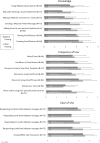Electronic health record (EHR) training program identifies a new tool to quantify the EHR time burden and improves providers' perceived control over their workload in the EHR
- PMID: 31984357
- PMCID: PMC6952029
- DOI: 10.1093/jamiaopen/ooz003
Electronic health record (EHR) training program identifies a new tool to quantify the EHR time burden and improves providers' perceived control over their workload in the EHR
Abstract
Objective: To understand if providers who had additional electronic health record (EHR) training improved their satisfaction, decreased personal EHR-use time, and decreased turnaround time on tasks.
Materials and methods: This pre-post study with no controls evaluated the impact of a supplemental EHR training program on a group of academic and community practice clinicians that previously had go-live group EHR training and 20 months experience using this EHR on self-reported data, calculated EHR time, and vendor-reported metrics.
Results: Providers self-reported significant improvements in their knowledge of efficiency tools in the EHR after training and doubled (significant) their preference list entries (mean pre = 38.1 [65.88], post = 63.5 [90.47], P < .01). Of the 7 EHR satisfaction variables, only 1 self-reported variable significantly improved after training: Control over my workload in the EHR (mean pre = 2.7 [0.96], post = 3.0 [1.04], P < .01). There was no significant decrease in their calculated EHR usage outside of clinic (mean pre = 0.39 [0.77] to post = 0.37 [0.48], P = .73). No significant difference was seen in turnaround time for patient calls (mean pre = 2.3 [2.06] days, post = 1.9 [1.76] days, P = .08) and results (mean before = 4.0 [2.79] days, after = 3.2 [2.33] days, P = .03).
Discussion: Multiple sources of data provide a holistic view of the provider experience in the EHR. This study suggests that individualized EHR training can improve the knowledge of EHR tools and satisfaction with their perceived control of EHR workload, however this did not translate into less Clinician Logged-In Outside Clinic (CLOC) time, a calculated metric, nor quicker turnaround on in box tasks. CLOC time emerged as a potential less-costly surrogate metric for provider satisfaction in EHR work than surveying clinicians. Further study is required to understand the cost-benefit of various interventions to decrease CLOC time.
Conclusions: This supplemental EHR training session, 20 months post go-live, where most participants elected to receive 2 or fewer sessions did significantly improve provider satisfaction with perceived control over their workload in the EHR, but it was not effective in decreasing EHR-use time outside of clinic. CLOC time, a calculated metric, could be a practical trackable surrogate for provider satisfaction (inverse correlation) with after-hours time spent in the EHR. Further study into interventions that decrease CLOC time and improve turnaround time to respond to inbox tasks are suggested next steps.
Keywords: EHR training; provider satisfaction; workload metrics.
© The Author(s) 2019. Published by Oxford University Press on behalf of the American Medical Informatics Association.
Figures




References
-
- Buntin M, Burke M, Hoaglin M, Blumenthal D.. The benefits of health information technology: a review of the recent literature shows predominantly positive results. Health Affairs 2011; 30 (3): 464–71. - PubMed
-
- Pérez E, Winters J, Gajic O.. The addition of decision support into computerized physician order entry reduces red blood cell transfusion resource utilization in the intensive care unit. Am J Hematol 2007; 82 (7): 631–3. - PubMed
-
- Amarasingham R, Plantinga L, Diener-West M, Gaskin D, Powe N.. Clinical information technologies and inpatient outcomes. Arch Intern Med 2009; 169 (2): 108.. - PubMed
LinkOut - more resources
Full Text Sources
